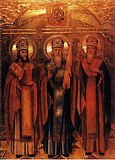 Hieromartyr Hierotheus, bishop of Athens (1st c.).
Hieromartyr Hierotheus, bishop of Athens (1st c.).  Uncovering of the relics (1595) of St. Gurias, first archbishop of Kazan, and St. Barsanuphius, bishop of Tver (1595).
Uncovering of the relics (1595) of St. Gurias, first archbishop of Kazan, and St. Barsanuphius, bishop of Tver (1595).  Synaxis of the Saints of Kazan.
Synaxis of the Saints of Kazan.
Martyrs Gaius, Faustus, Eusebius, and Chaeremon, of Alexandria (3rd c.). Hieromartyr Peter of Capitolia, bishop of Bostra in Arabia (715). Martyrs Domnina and her daughters Berenice (Bernice) and Prosdoce, of Syria (302). Martyr Adauctus (ca. 312) and his daughter St. Callisthene (ca. 318), of Ephesus. Sts. Paul the Simple (ca. 339) and Ammon (350), of Egypt, disciples of St. Anthony the Great. St. Vladimir Yaroslavich, prince of Novgorod (1052), and his mother St. Anna of Novgorod (1050). Sts. Helladius and Onesimus of the Near Caves in Kiev (12th c.-13th c.). St. Ammon, recluse, of the Far Caves in Kiev (13th c.). St. Stephen Stiljanovic, despot of Srem, Serbia (1540) and his wife St. Helen (Elizabeth in monasticism) (ca. 1543). Sts. Jonah and Nectarius, monks, of Kazan (16th c.).
New Hieromartyrs Basil (Tsvetkov), archimandrite, of Stary Kelets (Ryazan) and Tikhon Arkhangelsky, archpriest, of Kuiman (Voronezh) (1937). New Hiero-confessor Barsanuphius (Yurchenko) of Kherson (1954).
St. Theodore the Wonderworker, bishop of Tamassos, Cyprus (2nd c.). St. John (Lampadistes) of Cyprus (10th c.). Hieromartyr Evdemoz, catholicos of Georgia (1642).
Saturday. [I Cor. 15:58-16:3; Luke 5:17-26]
But that ye may know that the Son of
man hath power on earth to forgive sins, He said to
the paralytic, I say unto thee, Arise, and take up they
couch, and go into thine house. Remission of sins is
an inner, spiritual miracle; healing from paralysis is an
outer miracle—the natural acting of God in the
world, a physical miracle. The flowing in of God’s
power is justified and confirmed by this event in the
moral realm, and in the movement of phenomena in the
physical world. The latter is in view of the former, for
in the former lies the goal of everything. The Lord does
not coerce one’s freedom, but gives understanding,
inspires, and amazes. One of the best means for this is an
outer miracle. This came to be when man became a rational
creature, ruled by freedom. This connection is so
essential, that those who reject the supernatural action
of God in the world also reject the freedom of man, along
with the recognition that the latter must necessarily call
forth the former. On the other hand, those who confess the
truth of God’s influence in the world beyond a
natural flow of events can say boldly: we can feel that we
are free. The recognition of freedom is as strong and
irresistible as the recognition of one’s existence.
Freedom urgently demands direct providential actions of
God: consequently the acknowledgement of these actions
stands as firmly as the recognition of freedom.


![]() Hieromartyr Hierotheus, bishop of Athens (1st c.).
Hieromartyr Hierotheus, bishop of Athens (1st c.). ![]() Uncovering of the relics (1595) of St. Gurias, first archbishop of Kazan, and St. Barsanuphius, bishop of Tver (1595).
Uncovering of the relics (1595) of St. Gurias, first archbishop of Kazan, and St. Barsanuphius, bishop of Tver (1595). ![]() Synaxis of the Saints of Kazan.
Synaxis of the Saints of Kazan. 

















